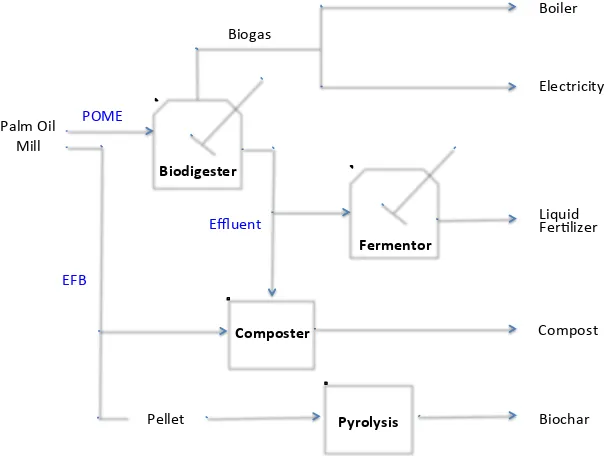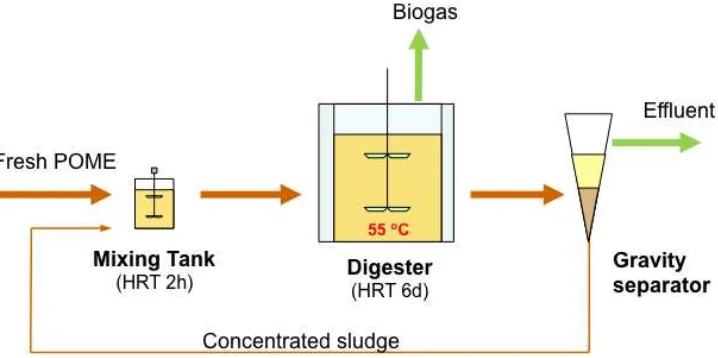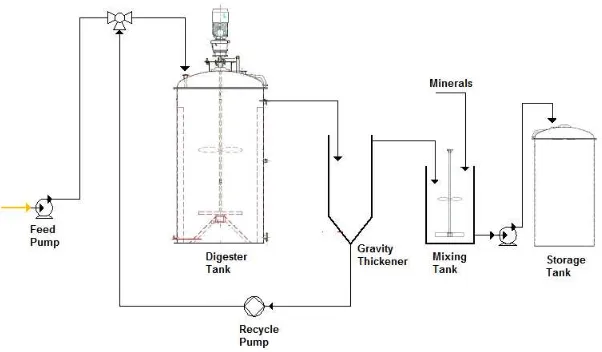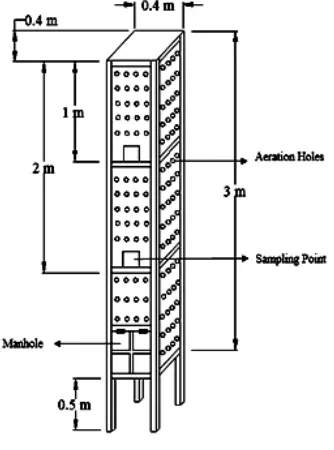PAPER • OPEN ACCESS
Processing of palm oil mill wastes based on zero
waste technology
To cite this article: Irvan 2018 IOP Conf. Ser.: Mater. Sci. Eng. 309 012136
View the article online for updates and enhancements.
Related content
The Potential of Palm Oil Waste Biomass in Indonesia in 2020 and 2030
E Hambali and M Rivai
-Performance Evaluation on Otto Engine Generator Using Gasoline and Biogas from Palm Oil Mill Effluent
Irvan, B Trisakti, T Husaini et al.
-Use of Oil Palm Waste as a Renewable Energy Source and Its Impact on Reduction of Air Pollution in Context of Malaysia
Shahida Begum, Kumaran P and Jayakumar M
Processing of palm oil mill wastes based on zero waste
technology
Irvan1,2,*
1Chemical Engineering Department, Universitas Sumatera Utara, Indonesia
2Sustainable Energy and Biomaterial Center of Excellence, Universitas Sumatera
Utara, Indonesia
*E-mail: [email protected]
Abstract. Indonesia is currently the main producer of palm oil in the world with a total production reached 33.5 million tons per year. In the processing of fresh fruit bunches (FFB) besides producing palm oil and kernel oil, palm oil mills also produce liquid and solid wastes. The increase of palm oil production will be followed by an increase in the production of waste generated. It will give rise to major environmental issues especially the discharge of liquid waste to the rivers, the emission of methane from digestion pond and the incineration of empty fruit bunches (EFB). This paper describes a zero waste technology in processing palm oil mill waste after the milling process. The technology involves fermentation of palm oil mill effluent (POME) to biogas by using continuous stirred tank reactor (CSTR) in the presence of thermophilic microbes, producing activated liquid organic fertilizer (ALOF) from discharge of treated waste effluent from biogas digester, composting EFB by spraying ALOF on the EFB in the composter, and producing pellet or biochar from EFB by pyrolysis process. This concept can be considered as a promising technology for palm oil mills with the main objective of eliminating the effluent from their mills.
1.Introduction
2
Table 1. Total number of Indonesia’s palm oil mills in 2015 [2]
Region Number of
Sumatera 775 3,116,572.51 7,927,136.02 482 18,797.5
Jawa 5 11,825.44 43,587.96 2 50.0
Borneo 371 2,824,955.43 3,309,309.57 246 3,075.3
Sulawesi 22 238,336.22 316,137.50 5 270.0
Papua 8 99,041.60 93,070.80 7 390.0
Total 1,181 6,290,731.20 11,689,241.85 742 22,582.8
Table 1 shows that most of palm oil mills are located in Sumatera, mainly in Riau and North Sumatera Province. In 2015, Riau and North Sumatera produce 4,237,736.70 and 793,176.28 tonnes palm oil, respectively [2]. During its operation, besides producing crude palm oil (CPO) and palm kernel, palm oil mill (POM) also produces wastes. Every ton of CPO, it discharges approximately 2.5 ton of palm oil mill effluent (POME), 0.9 ton of empty fruit bunches (EFB), 0.6 of mesocarp fibers, and 0.27 ton of shells. Therefore, in 2015 besides producing 31 million ton CPO, Indonesia also produced 77.5 million ton POME, 27.9 ton EFB, 18,6 ton mesocarp fibers and 8.4 million ton shells. It is a huge amount of waste, if it is not treated properly it will become a serious problem for the environment.
POME consists of 0.6–0.7% palm oil, 95–96% water, 4–5% total solid, and 2–4% suspended solids. The existing method that we often found to treat POME in the palm oil mills is the lagoon or pond system. This pond system consists of a series of anaerobic, facultative, and aerobic ponds. The purpose of this treatment is to reduce the quality of wastewater like BOD, COD, pH before being flown to the river. Although this method success to reduce quality of wastewater until 95% however it needs very long time. It needs around 55 until 100 days operation needs a larger area, and other disadvantage is release of gas house gases (GHG) like methane and CO2 to the atmosphere.
Some mills which care about the environment, try to reduce the GHG by covering the pond to trap the GHG and then burn into the atmosphere. Usually they make joint venture with other company. The biogas combustion process is essentially converting methane to CO2 as seen in the reaction. Although CO2 is also a greenhouse gas, but methane is considered 21 times more dangerous than CO2. So the advantage, we can do carbon trading. But the lack of this system is useless, because biogas is not used as fuel.
Approximately 20 – 22.5 tons of EFB are produced from 100 tons of FFB [3]. Indonesia is estimated to produce 90.5 million metric tons of FFB, resulting in EFB waste about 20.8 million metric tons per year [4]. EFB contains high cellulose, which relatively easy to decompose with a combination of biological, physical, and chemical processes [5]. Before 1996, EFB was burned in an incinerator to ashes. The ash of EFB can be used as fertilizer, because its potassium content is relatively high ± 30%. However, to prevent air pollution, the EFB combustion process is prohibited through Minister of Environment Decree number 15 of 1996 on the blue-sky program.
soil erosion but its utilization is costly for labor and transportation. Moreover, the processes of composting of mulch take a long time depending on environmental factors. Composting of EFB is also interesting way to reduce of solid waste from palm oil mills. However using open composting process take a long time and release GHG emission also. Zero waste technology offers a solution to solve the problem. This technology is a method how to manage waste which is designed to reduce the negative impact of palm oil wastes discharged into the environment.
2. Method
Zero waste technology involves fermentation of POME to biogas by using continuous stirred tank reactor (CSTR) in the presence of thermophilic microbes, producing activated liquid organic fertilizer (ALOF) from discharge of treated waste effluent from biogas digester, composting EFB by spraying ALOF on the EFB in the composter, and pyrolysis of EFB to biochar or pellet. The flow chart of this method is shown in figure 1.
Figure 1. Zero waste technology in palm oil mill
2.1. Fermentation of POME to Biogas
POME contains many saturated fatty acids such as, palmitic acid and stearic acid. The melting points of palmitic and stearic acids are 63 oC and 69.9 oC respectively. When POME is treated using the mesophilic (ambient) fermentation method, it is difficult to decompose these saturated fatty acids because the temperature of the mesophilic digester is usually around
35oC [6, 7, 8, 9, 10]. Even in the case of thermophilic fermentation at 55oC, it is difficult for anaerobic fermentation to treat such fatty acids at a high speed. Our research was conducted to treat POME by using an anaerobic digester in a thermophilic state. Fresh POME was mixed
with concentrated sludge previously separated by a gravity thickener in a mixing tank at 70oC; then the mixed slurry was pumped into an anaerobic digester. Schematic diagram of our system is shown on figure 2.
Palm%Oil%% Mill%
Biodigester* Biogas%
Boiler%
Electricity%
POME%
Effluent% Liquid%%Fer:lizer%
EFB%
Composter* Compost%
Fermentor*
Pyrolysis* Biochar%
4
Figure 2. Schematic drawing of POME fermentation to biogas
a. Laboratory experiment (2-5 l scale)
The experiment was conducted in a laboratory with a continuous stirred tank reactor (CSTR) of 2-liter scale at thermophilic temperature, 55 oC [11, 12]. We tried to extend the sludge retention time (SRT) by returning the concentrated sludge by means of a gravity separator. Here concentrated sludge and POME were mixed in a mixing tank at 70oC. Hydraulic retention time (HRT) of CSTR was maintained at 6 days. As a result of the laboratory scale test, methane production of 0.25 kg CH4/kg COD reduction was obtained and 63% CH4, 37% CO2 in biogas composition [13].
b. Pilot plant scale experiment (3.7 m3 scale)
Figure 3 is a photo of the pilot plant. The pilot plant with volume of the digester is 3.7m3 in this system was built in 2010 and has been operated at University of Sumatera Utara. POME was transported by trucks from palm oil mill to USU once a week.
Table 2 shows the results of the laboratory test and pilot plant test. The laboratory test and pilot plant test results indicated that high COD and volatile solid (VS) decomposition rate, more than 80%, can be achieved when using pre-heating and by extending SRT in the return sludge process, despite the short HRT of six days. In addition, biogas produced from pilot plant was used as fuel in the Otto engine generator 4 – stroke [14].
Table 2. Results of laboratory test and pilot plant test
Figure 3. Pilot plant
2.2. Activated liquid organic fertilizer from POME
Figure 4 shows flowsheet of liquid fertilizer production unit which extended process from biogas generation unit. Main equipments of this unit are digester tank capacity 5,000 L equipped with mixer and heater, gravity thickener tank capacity 1,000 L equipped with screw pump, mixing tank capacity 500 L equipped with mixer, and storage tank capacity 2,000 L. Effluent which came from biogas generation unit was pumped into fertilizer digester tank of liquid production unit intermittently every 2 hour. Inside the fertilizer digester, the feed (effluent from biogas digester) was degraded by anaerobic microbe, therefore COD concentration decreased from 10,000 mg/L become 1,500 mg/L. After that, the low COD effluent was flowed to gravity thickener by overflow. Inside the gravity thickener, the effluent was let to settle to the bottom of the tank.
Figure 4. Flowsheet of liquid fertilizer production unit
6
liquid fertilizer are shown in Table 3. Table 3 summarizes that liquid from fertilizer digester has high content of N, P, and K which are considered as the important components in fertilizer. Another interesting result, COD concentration decreased significantly from 8,600 to 1,500 mg/L, it makes the function of digester is not only for fertilizer production but also for wastewater treatment.
2.3. Composting empty fruit bunches (EFB)
During its operation, besides producing crude palm oil (CPO) and palm kernel, palm oil mill (POM) also produces waste, i.e. solid wastes such as EFB and POME. Several studies have been conducted for the processing of EFB into compost by adding additional materials such as animal wastes, and by mixing with POME [15]. In this research, the addition was carried out with active organic fertilizer (AOF) that serves as an activator and also maintains the
Composting of empty fruit bunches (EFB) mixed with activated liquid organic fertilizer (ALOF) is an alternative utilization of solid waste of palm oil mill [16]. Composting treatment was conducted by cutting EFB into pieces with size 1 - 3 cm, inserting the EFB into basket composter (33 cm W × 28 cm L × 40 cm H), and by adding ALOF until moisture
Figure 5. The tower composter
Composting process was conducted by putting non-shredded EFB into the composter tower and by adding ALOF as activator. The composting treatment was completed in a short time in 40 days, even though on day 10, EFB turned to dark brown indicating mature compost. The quality of final compost from day 10 until day 40 were slightly similar i.e. pH scale ranges from 7.6 to 8.4; moisture content 41.16 - 58.44%; 20.27 - 21.34% C, 1.02 - 1.25% N, C/N ratio of 19.94 - 20.24, bacterial count 17 - 41 × 106 CFU g-1, and electrical conductivity 3.735 - 4.9 dS.m-1. The quality of product compost obtained has met Indonesian National Standard (SNI).
2.4. Producing biochar from EFB by pyrolysis process
Biochar is a solid product of biomass pyrolysis which can be utilized as an alternative fuel. In addition as a fuel, biochar can also be converted to activated carbon then can be used in purification processes. The conversion of empty fruit bunches (EFB) to biochar through pyrolysis has the following stages: shredding, chopping, milling, pelletization, and pyrolysis of EFB into biochar, then analysis of biochar products
.
The steps of this process can be seen figure 6. Producing biochar from EFB by pyrolysis process is still under proceeding in our laboratory.8
1234567890‘’“”
TALENTA-CEST 2017 IOP Publishing
IOP Conf. Series: Materials Science and Engineering 309 (2018) 012136 doi:10.1088/1757-899X/309/1/012136
3. Conclusion
Zero waste technology can be considered as a promising technology for palm oil mills with the main benefits such as eliminating the effluent from the mills, production of biogas can generate electricity or as boiler fuel, production of compost or liquid fertilizer as chemical fertilizer substitution, production of biochar and pellet as fuel, green house gases reduction, and zero pollution to the environment.
Acknowledgment
This research was supported by Hibah BP-PTN Universitas Sumatera Utara fiscal year 2016.
References
[1] Index Mundi 2017) Indonesia Palm Oil Production by Year
http://www.indexmundi.com/agriculture/ ?country=id&commodity=palm-oil&graph= production, Retrieved 7 September 2017
[2] Directorate General Estate Crop, Ministry of Agriculture 2016 Agricultural Statistics Database, Jakarta: Ministry of Agriculture
[3] Kerdsuwan S, Krongkaew L 2011 Renewable Energy – Trends and Applications, Intech [4] Ishola M M, Isroi, Taherzadeh M J 2014 Bioresour. Technol. 165 9-12
Conference, Nusa Dua, Bali, Indonesia, July 8-12 265-275
[10] Najafpour G D, Zinatizadeh A A L, Mohamed A R, Isa M H, Nasrollahzadeh H 2006
Proc. Biochem.41 370-379
[11] Irvan, Trisakti B, Sosanty F and Tomiuchi Y 2016, Asian J. Chem.28 377-380 [12] Irvan, Trisakti B, Wongistani V and Tomiuchi Y 2012, Int. J. Sci. Eng. 3 32-35
[13] Irvan, Trisakti B, Tomiuchi Y, Harahap U, Daimon H 2017 IOP Conf. Series: Materials
Sci. Eng.206 012094
[14] Irvan, Trisakti B, Husaini T, Sitio A, Sitorus T B 2017 IOP Conf. Series: Materials Sci. Eng.206 012028
[15] Baharuddin A S, Wakisaka M, Shirai Y, Abd-Aziz S, Abdul Rahman A N, Hassan, M A 2009 Int. J. Agri. Res. 4 69-78
![Table 1. Total number of Indonesia’s palm oil mills in 2015 [2]](https://thumb-ap.123doks.com/thumbv2/123dok/3906982.1859842/3.595.56.541.137.287/table-total-number-of-indonesia-palm-oil-mills.webp)



